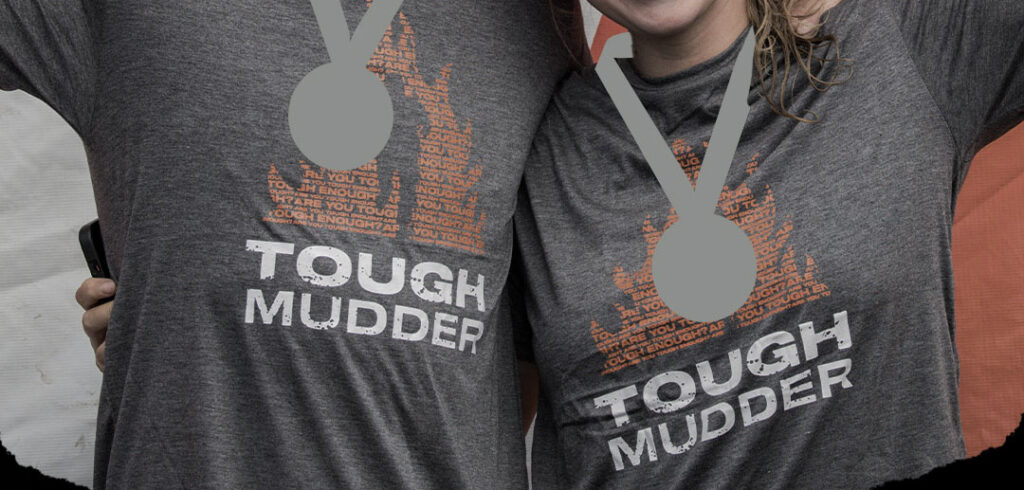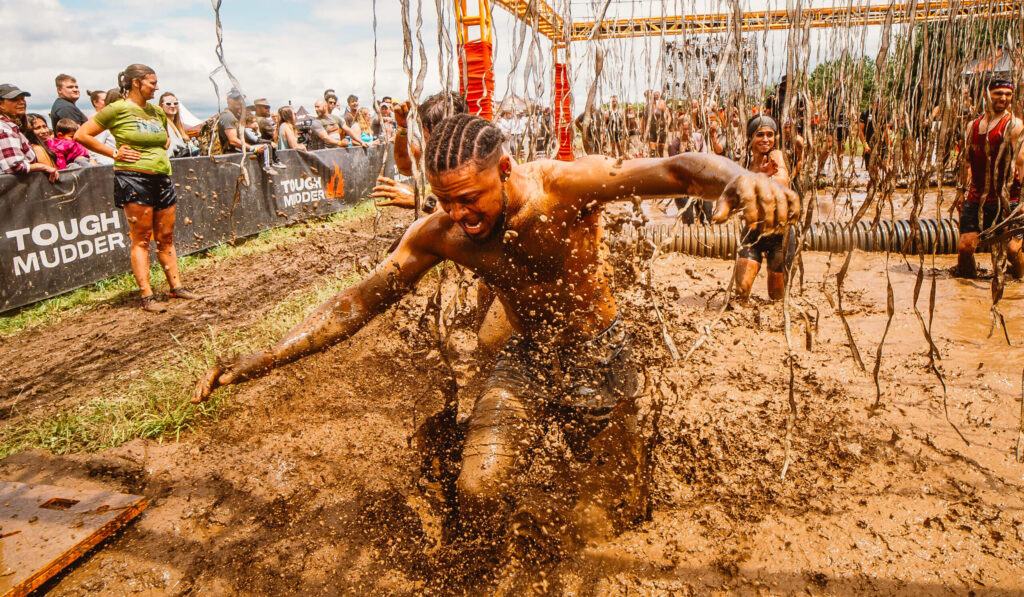Looking for tips on how to build endurance? Well, if you’re thinking of tackling a Tough Mudder, you’ll need it. With 10+ miles of muddy terrain and 20+ obstacles that require strategy, muscular endurance, and a team of Mudders pulling you through, Tough Mudder obstacle course races will challenge your muscular stamina and cardiovascular capacity. As a Mudder, you need to be able to get your heart rate up and maintain it for an extended period of time as you run through mud and scale walls, especially if you’re an athlete competing in the Tough Mudder Competitive Series, says Melody Scharff, C.P.T. trainer at Fhitting Room. Basically, she says, endurance is key.
Endurance allows Mudders to work out aerobically at certain (read: high) intensities for an extended period of time. VO2max and lactate threshold are the two most important measures of aerobic capacity. VO2 max is the maximum rate at which an athlete’s body can consume oxygen during exercise; improving maximal oxygen intake with targeted training can improve endurance ability, says Dr. Grayson Wickhman PT, DPT, CSCS, founder of Movement Vault. Lactic threshold is the second piece of the endurance puzzle, which is the level of exertion that lactic acid accumulates in the muscles.
Lucky for Mudder Nation, both of these measures can be improved with smart training. (And psst: we’re not talking about cranking out miles on your training runs.) So try these six tips on how to improve endurance without running—finisher headband, here we come.
How to Build Endurance
Hit Up HIIT
In and out of the mud, high intensity interval training is considered paramount for training. HIIT requires that you first work as hard as you possibly can for short bursts of time (20, 30, 45, or 60 seconds) and then recover for another short burst. “HIIT is best used to improve cardiovascular endurance when you focus on full body or compound movements. 45 seconds of slow bicep curls isn’t going to benefit your cardio in the same way 45 seconds of jumping lunges will,” says Scharff.
The most popular version of HIIT exercise is Tabata sprints, which are 20 seconds on, 10 seconds off for 4 minutes (or 8 rounds) of high intensity movements; since you’re only working for 20 seconds at a time the goal is to give 100% of your effort 100% of the time. Scharff recommends that someone working on their cardiovascular endurance incorporates at least 2 tabata workouts into their training schedule each week, such as an assault bike, burpee, or box jump tabata. Or- for Mudders who are short on time- drilling through 4-5 different Tabata workouts for a killer workout in under 20 minutes.
MORE: The Tabata Workout You Need for Tough Mudder
Incorporate Steady State Cardio
High Intensity interval training (HIIT) is the best way to find that max heart rate, explains Scharff, but adding in some steady-state cardio for longer intervals of time is what you need to bring your endurance to the next level. 20, 30 even 40 minutes will get you cardiovascularly prepared for Tough Mudders, which take on average 3.5 hours to complete. Many athletes shy away from longer cardio workouts because they think running is the only way to improve steady-state cardio endurance. But other monolithic exercises like biking, swimming, rowing, and elliptical training will also do the trick, and are a great substitute with athletes who either have joint issues or simply hate running. Plus, longer monolithic training workouts will also mentally prepare you for the demands of the course.
Add In Explosive Exercises
Plyometrics are a type of high intensity training that tap into energy stored in muscles for explosive movements, which help encourage muscular development, agility, cardiovascular conditioning, stamina, and speed—all of which are important for obstacle course racing, says Yusuf Jeffers, a NASM-certified personal trainer. Once you become more explosive, you’ll find that you are able to actually move faster through the mud and on the course. Adding in box jumps, burpees, and power push-ups to your training routine will improve the muscular endurance you need on the Tough Mudder course.
MORE: 6 Plyo Moves That’ll Prep You for the Mud
Eat Right
As you push through your Tough Mudder training, fueling your body the right way will not only prepare you for your next Tough Mudder event, but also continue on to your next fitness goal. That means consuming lots of protein and carbs. Our bodies turn carbs into energy by breaking them down into sugar (called glucose). Then, our small intestine absorbs that glucose and releases it into our bloodstream. Once that glucose is in the bloodstream, we can use it as immediate energy. Without these carbs, the body might break down muscle for fuel instead, explains Leslie Bonci, M.P.H., R.D., C.S.S.D., of Active Eating Advice. Definitely not something we want. So increasing carbohydrate intake will help replace the glycogen that is getting burned up in training.
Protein helps our muscles repair and grow, which means that with proper protein intake, the body is better equipped to preserve and build muscle than if we skip the protein. Keri Gans, M.S., R.D.N., certified yoga instructor and owner of Keri Gans Nutrition, recommends that Mudders in training should consume 2-3 grams of carbohydrates per pound of body weight (such as oatmeal, whole grains, sweet potatoes, fruit, and vegetables) and at least 1 gram of protein (such as lean chicken, Greek yogurt, and eggs) per pound of body weight to keep their bodies running smoothly.
MORE: 9 High-Protein Snacks You Can Take On the Go
Rest
As tough of a Mudder as you might be, your body still needs some R&R if you want to get tougher, stronger, and faster. Neglect recovery for too long and you’ll sink into a pit of overtraining that’s harder to walk out of than a 5′ deep mud pit at mile 8. Basically, when you train you’re essentially causing trauma to your body; every time you exercise you are creating micro-tears in your muscles, which grow back stronger when they repair. Without proper rest, there is not enough time for the muscles to grow back stronger. The key is to train smarter—NOT harder.
MORE: 8 Signs You Need a Rest Day
Mix It Up
Remember: routine is the enemy. Switching up your workouts is essential to building endurance. Once you find your training niche, don’t stick to just that. Getting to that personal best in the mud means working on what’s weak. Check out our workouts on YouTube or find a Tough Mudder Bootcamp near you.
Ready to commit? Sign up for a Tough Mudder today.
Gabrielle Kassel is a New York-based fitness and wellness writer and CrossFit Level 1 trainer. When she’s not lifting heavy sh*t, playing rugby, or getting downright dirty, she can be found reading memoirs and guzzling cold brew. Follow her on Instagram.




